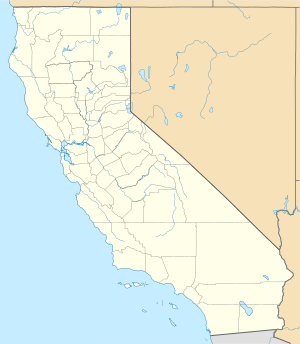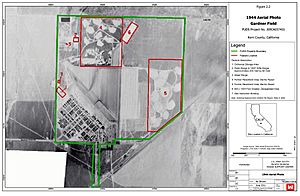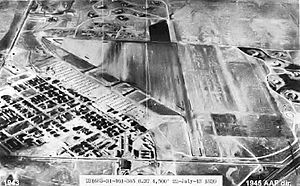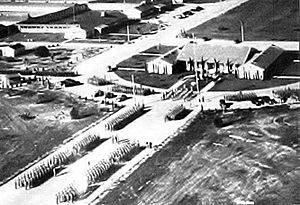Gardner Army Airfield facts for kids
Quick facts for kids Gardner Army Airfield
|
|
|---|---|
| Part of Army Air Force Training Command | |
| Kern County, near Taft, California | |

Aerial photo of the remains of Gardner AAF, 2006. The largest remaining recognizable element of the airfield is the 1,800' concrete and asphalt ramp area, which runs diagonally NW/SE in the photo.
|
|
| Coordinates | 35°06′21″N 119°18′21″W / 35.10583°N 119.30583°W |
| Type | Army airfield |
| Site information | |
| Controlled by | United States Army Air Forces |
| Site history | |
| Built | 1941 |
| In use | 1941–1945 |
| Garrison information | |
| Garrison | Army Air Force Training Command |
Gardner Army Airfield was a special place where pilots learned to fly during World War II. It was a base for the United States Army Air Forces, located about 9 miles southeast of Taft, California. The airfield was named after Major John H. Gardner, a brave pilot from World War I.
This airfield is famous because Major General Charles Elwood "Chuck" Yeager, a very well-known test pilot, took his first flying lessons here. He later became the first person to fly faster than the speed of sound!
Contents
History of Gardner Army Airfield
Building the Airfield for Pilot Training
In 1940, before the United States joined World War II, the Army Air Corps needed more pilots. They decided to build new training bases quickly. On January 17, 1941, Army representatives visited Taft, California. They chose a large farming area to build a basic flying training school.
The Army started by leasing 880 acres of land. Over time, they added more land, reaching a total of 1,396 acres by May 1943. Construction began right away. Workers built runways, airplane hangars, and a control tower. The airfield had three asphalt runways shaped like a triangle. They were very long, perfect for training planes.
What the Base Looked Like
The base also had a large area for parking planes and several big hangars. Most buildings were built quickly using simple materials like plywood. They weren't meant to last a long time. Even so, the base had everything the soldiers and cadets needed. This included a hospital, a sewage plant, administration buildings, dining halls, and many barracks for sleeping.
Auxiliary Fields: Helping the Main Base
Besides the main airfield, six smaller "auxiliary fields" were built nearby. These extra fields helped with training and gave pilots more space to practice. They were:
- Parker Field (Aux#1) 35°03′50″N 119°12′15″W / 35.06389°N 119.20417°W
- Kern Field Aux#2) 35°03′50″N 119°05′40″W / 35.06389°N 119.09444°W
- Allen Field (Aux#3) 35°03′16″N 119°01′05″W / 35.05444°N 119.01806°W
- Conners Field (Aux #4) 35°03′47″N 119°05′40″W / 35.06306°N 119.09444°W
- Taft Field (Aux#5) 35°07′10″N 119°20′10″W / 35.11944°N 119.33611°W
- Cuyama Field (Aux#6) 34°51′15″N 119°28′45″W / 34.85417°N 119.47917°W
Today, these auxiliary fields are gone. The land around Taft is mostly used for farming, so there are no signs of them left.
Training Pilots for War
Gardner Army Airfield officially opened on October 26, 1941. Over 10,000 people came to the dedication ceremony. The base used planes like the Vultee BT-13 and Boeing-Stearman Model 75 PT-17 for basic pilot training. Many different squadrons, or groups of planes and pilots, were based there.
The last class of pilots graduated from Gardner in January 1945. By then, the base had trained 3,050 soldiers and 8,916 cadets. Sadly, 26 cadets and 11 training officers died in flying accidents. However, considering how many hours were flown, the number of crashes was quite low.
Closing Down the Airfield
As World War II was ending, the need for new pilots decreased. The planes left, and the buildings were taken down. Gardner Army Airfield officially closed on February 28, 1945. The land was later given back for other uses, mostly farming.
Today, you can still see a few parts of the old airfield. Some remains of the sewage treatment plant and the large concrete parking area are still there. This area is now used to store farm equipment.
Gardner Airport: After the War
After World War II, Gardner Army Airfield was no longer needed by the military. For a few years, it was used as a regular airport called Gardner Airport. However, it eventually closed down sometime between 1949 and 1964.
There is also a special monument at the spot where the base's main entrance used to be. It's located at the corner of Cadet and Basic School Roads, remembering the airfield's history.





